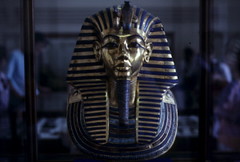 The recent discovery that involves the DNA of King Tut may have brought this ancient Pharaoh back into the public consciousness. Now that we know more about the descendants of King Tut, it would be good to go back and figure out his family tree that includes his closest relatives.
The recent discovery that involves the DNA of King Tut may have brought this ancient Pharaoh back into the public consciousness. Now that we know more about the descendants of King Tut, it would be good to go back and figure out his family tree that includes his closest relatives.
Scientists recently discovered that King Tut belonged to a haplogroup called R1b1a2. This was learned after the scientists reconstructed the DNA of “the boy king”. It turns out that the R1b1a2 haplogroup is the same one that includes more than 50% of all men in Western Europe. It is believed that a common ancestor that links everyone together was someone who lived in the Caucasus around 9,500 years ago.
In order to create a family tree for King Tut, it might be easiest to start with him, and work from there. He was born in 1341 BC, and his original name was Tutankhaten, which means “living image of Aten”. Aten was an Egyptian deity.
His name was changed to Tutankhamen, which means “living image of Amun”, after he became a Pharaoh of Egypt. Amen was another Egyptian deity. After King Tut became Pharaoh, (which happened when he was around nine or ten years old), he ended the worship of Aten that was instituted during King Tut’s father’s reign as Pharaoh, in favor of a worship of Amen.
King Tut’s father was Akhenaten, (who was previously called Amenhotep IV, before he became Pharaoh.) Akhenaten had several royal consorts, including Nefertiti, Kiya, and a woman who was believed to be the sister of Akhenaten. This Pharaoh had several children with these women, one of whom was Tutankhamen.
Little is known about King Tut’s mother. DNA testing shows that her remains are those that scientists have referred to as “The Younger Lady”. The DNA also confirms that King Tut’s mother was a biological sister to King Tut’s father, Akhenaten. This would mean that technically, King Tut’s mother was also his aunt, and that King Tut’s father was also his uncle.
King Tut’s grandfather, (Akhenaten’s father), was Amenhotep III. He had three royal consorts: Tiye, Gilukhepa, and Tadukhepa. Amenhotep fathered several children with these women. Tiye is the mother of Akhenaten, which makes her King Tut’s grandmother.
For sake of clarity, I am leaving many of King Tut’s relatives out of this family tree. He had several siblings, many of whom were half siblings. His father also had several siblings and half siblings, which makes this family tree branch out even further. Things get more complex when you take into account that it was a practice of the ancient Egyptian royalty to marry people whom they were close biological relatives to. Today, this would be defined as incest.
King Tut married a woman named Ankhesenamun. She was his half sister. Both of them had the same father, Akhenaten, but different mothers. Ankhesenamun’s mother was Nefertiti. This makes King Tut’s father-in-law, and his father (who was also his uncle), the same exact person. King Tut’s mother-in-law is the mother of his half sister, (who is also his wife). There is evidence that King Tut and Ankhesenamun had two daughters, each of whom was stillborn.
Image by FatPassport on Flickr

